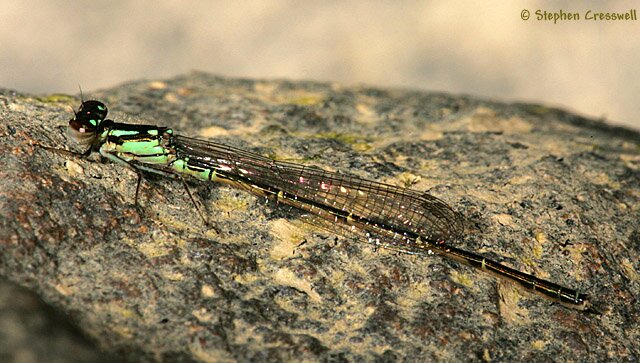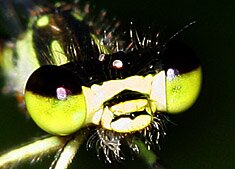

Family: Coenagrionidae
Length: 21-29 mm
Large numbers of Fragile Forktails may be seen at almost every pond and marsh in West Virginia. They are easy to miss, measuring only one inch in length, and flying only very slowly in and out of the weeds.
There are two key traits to look for in identifying this species. One is the presence of a broken, light-colored shoulder stripe that looks like an exclamation point. The other trait is the lack of a blue or whitish tip to the abdomen.
The exclamation point is present in both sexes, but in the case of the male the exclamation point is green, while on females it may be blue, tan, or gray. The dark abdomen tip is present in both sexes, but is a key identifying characteristic only in the male.
As female Fragile Forktails get older, they become harder to identify to species. They become pruinose (covered with a bluish waxy substance) so that their earlier coloration is no longer visible.
Robinson, Bronstad, and Bronstad (1985) reported the females spend as much time perching at ponds as do males. Both males and females remain at the ponds over night, but shift to higher perches for the night. Although in daytime high perches can leave the damselflies vulnerable to predation from above (from birds, robber flies, and other Odonates), at night this danger is very much reduced. The higher perches put the damselflies in position to catch the early, warming rays of the sun.
DNA studies have probed the relationship of various Ischnura species. They have demonstrated that, of the species found in West Virginia, Ischnura posita is fairly closely related to Ischnura verticalis, while Ischnura hastata is less closely related.

|
|
|
|
|
| Side view of the head and thorax of the Fragile Forktail. A male is pictured above, while color variants of the female are pictured in the two photos below. The females "exclamation point" may be tan, gray, or blue. |
|
|
|
|

|
| Above and below: Two photographs showing the face of Fragile Forktails. A male is pictured above, and a female below. Note the difference in eye color of the male and female. |

|


